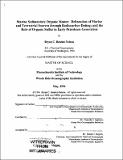| dc.contributor.advisor | Dr. Timothy I. Eglinton. | en_US |
| dc.contributor.author | Benitez-Nelson, Bryan C | en_US |
| dc.contributor.other | Woods Hole Oceanographic Institution. | en_US |
| dc.date.accessioned | 2010-09-14T18:06:07Z | |
| dc.date.available | 2010-09-14T18:06:07Z | |
| dc.date.issued | 1996 | en_US |
| dc.identifier.uri | http://hdl.handle.net/1721.1/58536 | |
| dc.description | Thesis (M.S.)--Joint Program in Oceanography and Oceanographic Engineering (Massachusetts Institute of Technology, Dept. of Earth, Atmospheric, and Planetary Sciences; and the Woods Hole Oceanographic Institution), June 1996. | en_US |
| dc.description | "May 1996." | en_US |
| dc.description | Includes bibliographical references (leaves 66-68). | en_US |
| dc.description.abstract | This thesis details two years of research conducted with the guidance and support of three advisors: Dr. J. K. Whelan, Dr. J. S. Seewald and Dr. T. I. Eglinton. Each of the three chapters represents a different, self-contained research project. All of the projects are related to the organic geochemistry of marine sediments, however, this is a fairly encompassing area of study. Chapters 1 and 2 stem from the same experimental study -- the use of hydrous-pyrolysis to investigate mechanisms leading to the production of petroleum-related products during kerogen maturation. Chapter 3, on the other hand, utilizes a recently developed technique of isolating and AMS-14C dating individual compounds from complex sedimentary organic mixtures. The samples used in each investigation came from all over the world. The first two chapters utilize ancient marine sediment samples obtained from an outcrop in California (Chpts. 1 and 2) and from a well in Alabama (Chpt. 2). In contrast, recent marine sediment samples were obtained from the Arabian and Black Seas for the third chapter. Several preparative and analytical methods are common to all three studies. Nevertheless, each employ techniques totally unique from one another and from previous investigations. In Chapter 1, for example, X-ray absorption spectroscopy (XANES) is used to determine the speciation of organic sulfur present in kerogen, bitumen, and bulk sediment samples. While Chapter 3 represents the first study in which the "4C ages of individual, known hydrocarbon biomarkers are determined after isolation by Preparative Capillary Gas Chromatography (PCGC). The insights gained by these investigations are discussed in detail in the following chapters. The common thread between the three chapters is that the source of organic matter, the rate at which it is delivered to marine sediments and the depositional environment, all set the stage for kerogen formation and eventual petroleum generation. | en_US |
| dc.description.statementofresponsibility | by Bryan C. Benitez-Nelson. | en_US |
| dc.format.extent | 68, [10] leaves | en_US |
| dc.language.iso | eng | en_US |
| dc.publisher | Massachusetts Institute of Technology | en_US |
| dc.rights | M.I.T. theses are protected by
copyright. They may be viewed from this source for any purpose, but
reproduction or distribution in any format is prohibited without written
permission. See provided URL for inquiries about permission. | en_US |
| dc.rights.uri | http://dspace.mit.edu/handle/1721.1/7582 | en_US |
| dc.subject | Joint Program in Oceanography and Oceanographic Engineering. | en_US |
| dc.subject | Earth, Atmospheric, and Planetary Sciences. | en_US |
| dc.subject | Woods Hole Oceanographic Institution. | en_US |
| dc.subject.lcc | GC7.8 .B46 | en_US |
| dc.subject.lcsh | Radiocarbon dating | en_US |
| dc.subject.lcsh | Organic geochemistry | en_US |
| dc.subject.lcsh | Marine sediments | en_US |
| dc.title | Marine sedimentary organic matter: delineation of marine and terrestrial sources through radiocarbon dating; and the role of organic sulfur in early petroleum generation | en_US |
| dc.type | Thesis | en_US |
| dc.description.degree | M.S. | en_US |
| dc.contributor.department | Joint Program in Oceanography and Oceanographic Engineering | en_US |
| dc.contributor.department | Woods Hole Oceanographic Institution | en_US |
| dc.contributor.department | Massachusetts Institute of Technology. Department of Earth, Atmospheric, and Planetary Sciences | |
| dc.identifier.oclc | 34608514 | en_US |
